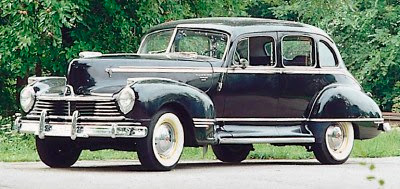Post-war Hudsons seem to be coming out of the woodwork these days. This August we spied one at a McDonald's in Erie, P. A. Then, last month, one showed up at the Frontier Cafe, Stevensville, Montana. Pictured is one that surprised us while photographing a herd of Red Angus, near the Mission Range, western Montana.
This convertible appears to bear––at first glance––its original factory paint as did the others we ran across. Forest Green in P. A. and in Montana, black with a white top. Convertibles are quite rare. This 1948-49 example wears the distinctive headband that became a clue to quick identity when meeting oncoming traffic.
Hudsons were attractively styled, especially pre-and post- WWII versions, and later, the marque led the way with its innovative Step-down body and chassis design, giving the car a sleek, long, and lower profile that appeared to hug the highway. This "torpedo" styling incorporated "Monobilt" unitized construction with perimeter frame rails and a lower center of gravity than its competition.
Hug the road it did. Coupled with power plants that delivered good top end on the track, 1950 Hudsons dominated stock car races around the nation. They were recognized for their track-savvy manners and handling, beating most entries of the Big Three. Not until the Rocket 88s fielded by Oldsmobile, did the Hudson face a real challenge during those few years, the heyday of its glory.
A dignified 1940-41 coupe that seated three. A modest rear seat could be installed as an option. Below are several 1946-47 models: to my mind some of the most attractively styled of all makes and models available after WWII. Note the hidden running boards.
Even a three-quarter ton pickup was marketed.
The company merged with Nash-Kelvinator in the mid-50s to survive against the Big Three. Despite its innovations in cabin comfort and size, industry-leading transmission options, and advanced suspension and steering engineering, Hudson's fortunes continued downhill even under the banner of American Motors Corporation, headed by George Romney. The badge disappeared altogether in 1957 but is still honored by such auto clubs as the Hudson-Essex-Terraplane owners who enthusiastically keep the memories alive and interest growing.
Here is a Hudson Terraplane, a lower-priced Hudson marketed as an entry-level vehicle, competitively priced in the mid-to late-1930s. I found this one at a Hermitage, Pennsylvania car show.
Here is a Hudson Terraplane, a lower-priced Hudson marketed as an entry-level vehicle, competitively priced in the mid-to late-1930s. I found this one at a Hermitage, Pennsylvania car show.








No comments:
Post a Comment